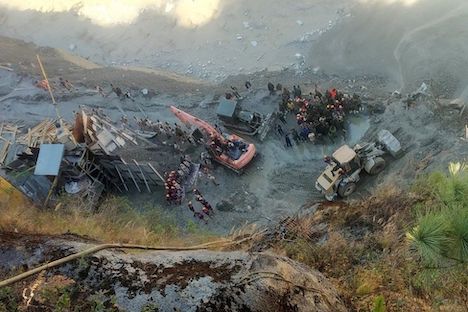|

|
Uttarakhand glacier disaster: Race to rescue 200 people missing in India
 Print This Print This
By Staff Writers | BBC
from BBC News
Monday, Feb 8, 2021
 |
| Rescue team members work near a tunnel after a part of a glacier broke away and caused flood in Tapovan, northern state of Uttarakhand, India. Photo: 8 February 2021 |
Emergency workers are searching for as many as 200 people still missing after a piece of a Himalayan glacier fell into a river and triggered a huge flood in northern India, killing 18.
The floodwaters burst open a dam and a deluge of water poured through a valley in the state of Uttarakhand on Sunday. Most of the missing are believed to be workers from two hydropower plants.
The rescue effort is focused on several sites, including a tunnel more than 200 metres (656ft) long. More than 30 people were apparently trapped inside when the torrent of icy water swept down the valley, carrying rocks and earth as it gathered speed. There has been no contact with them since. The rescue teams hope to clear the tunnel by nightfall.
Hundreds of troops, paramilitaries and military helicopters have been sent to the region to help with rescue efforts.
An investigation is continuing into what caused the glacial burst.
Speaking from hospital, one man described the moment the tunnel flooded. "We heard screams, 'get out, get out'. We didn't know what was happening. We started running to escape when the force of the water gushed in through the mouth of the tunnel. We couldn't get out because of that," he said. "We held on to the [roof] of the tunnel. We held on for about an hour. As the water receded, we slowly climbed onto the big rocks that flowed in, to take a breath. We had lost hope. We didn't think we would survive."
Police said the impact catapulted water along the Dhauliganga river, damaging another power project downstream in the Tapovan area.
Senior police officials said a bridge in the Tapovan area that connected 13 villages was washed away in the avalanche. Food packets were air dropped in some of these villages.
Sunday's disaster has prompted calls by environment groups to review power projects in the ecologically sensitive mountains. "Avalanches are common phenomena in the catchment area," MPS Bisht, director of the Uttarakhand Space Application Centre, told AFP news agency. "Huge landslides also frequently occur."
Uma Bharti, a former water resources minister, said she had spoken out against power projects on the Ganges and its tributaries.
Source URL
|
 Print This Print This

|
If you appreciated this article, please consider making a donation to Axis of Logic.
We do not use commercial advertising or corporate funding. We depend solely upon you,
the reader, to continue providing quality news and opinion on world affairs. Donate here
|
 |
Featured

|

